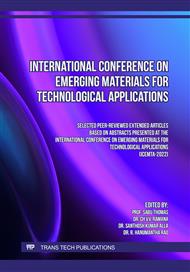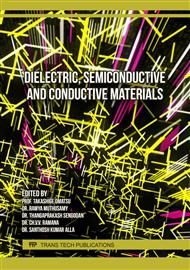[1]
Ning Li, Xiangdong Chen, Xinpeng Chen, Xing Ding and Xuan Zhao, RSC Adv., 7, 45988, (2017)
Google Scholar
[2]
Sajjad Sedaghat, 2013, World Applied Sciences Journal 21, (4), 544-547, (2013)
Google Scholar
[3]
Zehra Durmus, Ali Durmus, Huseyin Kavas, Journal of Material Science, 50, 1201–1213, (2015)
Google Scholar
[4]
M. Revanasiddappa, D Siddalinga Swamy S.C. Raghavendra and Y.T. Ravikiran, International Journal of Latest Technology in Engineering, Management & Applied Science, 3(11), 1-3, (2014)
Google Scholar
[5]
Tagreed M.Al-saadi, Mustafa A.K. Jihad International Journali of Advanced Research in Science, Engineering & Technology, 2(10), 902-909,(2015)
Google Scholar
[6]
M. Ristic, E. De Grave, S. Musi C, S. Popovi and Z. Orehovec, Journal of Molecular Structure, vol. 834–836, 454–460, (2007)
Google Scholar
[7]
A. Sari, S. Musi, K. Nomura and S. Popovi, Journal of Molecular Structure, vol. 480-481, 633–636, (1999)
Google Scholar
[8]
M. Zic, M. Risti and S. Musi, Journal of Molecular Structure, vol. 924–926, p.235–242, (2009)
Google Scholar
[9]
Z. wang, Y. Lu, S. Yuan, L. Shi, Y. Zhao, M. Zang and W.Deng, 2, J. Colloidal interface science, 396, 9-15, (2013)
Google Scholar
[10]
Narsimha Parvatikar, Shilpa Jain, Syed Khasim, M. Revansiddappa, S.V. Bhoraskar, M.V.N. Ambika Prasad Sensors and Actuators B, 114(2), 599-603, (2005)
DOI: 10.1016/j.snb.2005.06.057
Google Scholar
[11]
M Revanasiddappa, D Siddalinga Swamy, Vinay K, Y T Ravikiran, Raghavendra S C, American Institute of Physics conference proceedings, Volume 1953, 090070, 090070-1-090070-5, (2018)
Google Scholar
[12]
Vinay K, Shivakumar K, Y T Ravikiran, M Revanasiddappa, American Institute of Physics conference proceedings, Volume 1953, 090069, 090069-1-090069-5, (2018)
Google Scholar
[13]
Vinay K, Shivakumar K and Revanasiddappa M, International Journal of Emerging Technologies in Computational and Applied Sciences, 21, 22-26, (2017)
Google Scholar
[14]
D.S. Baudreaux, R.R. Chance, J.F. Wolf, L.W. Shacklette, J.L. Bredas, B. Themans, J.M, Andrea and R. Silbey, J. Chem Phys. 85(8), 4584, (1980)
Google Scholar
[15]
Yang C, Li H, Xiong D, Cao Z, 2009, Reactive Functional Polym. 69,137–144, (2009)
Google Scholar
[16]
S.C Nagaraju, Aashis S.Roy, J.B. Prasanna Kumar, Koppalkar R. Anilkumar, and G.Ramagopal, Journal of Engineering, Hindawi Publishing Corporation, 1-8, (2014)
Google Scholar
[17]
Muhammad H. Zahari, Beh H. Guan, Ee M. Cheng, Muhammad F. Che Mansor Hazliza A. Rahim, Progress In Electromagnetics Research M, Vol. 52, 111–118, (2016)
Google Scholar
[18]
Hemant Shinde, Sagar M. Kakani, Sacchidanand Shinde, A. M. More, J. A. Kher, Sunil R. Patil, Int. Journal of Innovative Research in Science,Engineering&Technology,3(6),14164-14171, (2014)
Google Scholar
[19]
A. Hakeem, A.Shakoor, M. Irfan, I. Alib, M. Azhar khan, B. M. Naeem Ashiq, M. Ishaq, A. Aziz, Journal of Ovonic Research, 10(5), 149 – 156, (2014)
Google Scholar
[20]
Wenyan Xue, Hong Qiu, Kun Fang, Jing Li, Jingwei zhao, Mei Li, Synthetic Metals,156, 833-837, (2006)
Google Scholar
[21]
S. Kotresh, Y. T. Ravikiran, S.C. Vijaya Kumari, H.G. Raj Prakash, S. Thomas, Adv. Mater. Lett. 6(7), 641-645, (2015)
DOI: 10.5185/amlett.2015.5795
Google Scholar
[22]
Vinod pillai, promod kumar, Manu s Multani, Dinesh O.Shah, (1993), Colloids and surfaces A:Physio chemical and engineering aspects,80, 69-75.
Google Scholar
[23]
R. J. Ramalingam, H. A. Al-Lohedan,T. Radhika, (2016), Digest Journal of Nanomaterials and Biostructures 11(3), 731 - 740
Google Scholar
[24]
M. Kooti, P Kharazi, H. Motamedi, (2014), J. Mater. Sci.Technol., 30(7), 656-660
Google Scholar
[25]
J B M Krishna, A Saha, G S Okram, A Soni, S Puraka yastha and B Ghosh, (2009), J. Phys. D: Appl. Phys. 42, 095404.
Google Scholar



